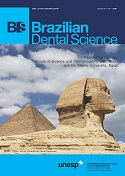Effects of Bacillus subtilis on Candida albicans: biofilm formation, filamentation and gene expression
DOI:
https://doi.org/10.14295/bds.2019.v22i2.1692Abstract
Objective: The aim of this study was evaluate the effect of Bacillus subtilis on Candida albicans biofilm formation and filamentation by evaluating the gene expression of ALS3, HWP1, BCR1, EFG1 and TEC1. Material and Methods: Mixed (C. albicans / B.subtilis) and monotypic biofilms were cultured in plates at 37°C for 48 h under shaking for counting viable cells (CFU / mL) and analysis of gene expression by real-time PCR. The C. albicans filamentation assay was performed in medium containing 10% fetal bovine serum at 37°C for 6 hours. Data was analysed by t-Student and Mann– Whitney tests. Results: B. subtilis reduced the biofilm formation of C. albicans in 1 log when cultured in the same environment (p<0.0001). In addition, it significantly reduced the yeast -hypha transition affecting the morphology of C. albicans. Among all of the analyzed genes, the ALS3 and HWP1 genes were the most affected, achieving 111.1- and 333.3- fold decreases in the C. albicans biofilms associated with B. subtilis, respectively. Conclusion: B. subtilis reduced the biofilm formation and filamentation of C. albicans by negatively regulating the ALS3, HWP1, BCR1, EFG1 and TEC1 genes that are essential for the production of biofilm and hyphae.
Keywords
Bacillus subtilis; Candida albicans; Biofilm; Filamentation; Gene expression.
Downloads
Downloads
Additional Files
Published
How to Cite
Issue
Section
License
Brazilian Dental Science uses the Creative Commons (CC-BY 4.0) license, thus preserving the integrity of articles in an open access environment. The journal allows the author to retain publishing rights without restrictions.
=================




























